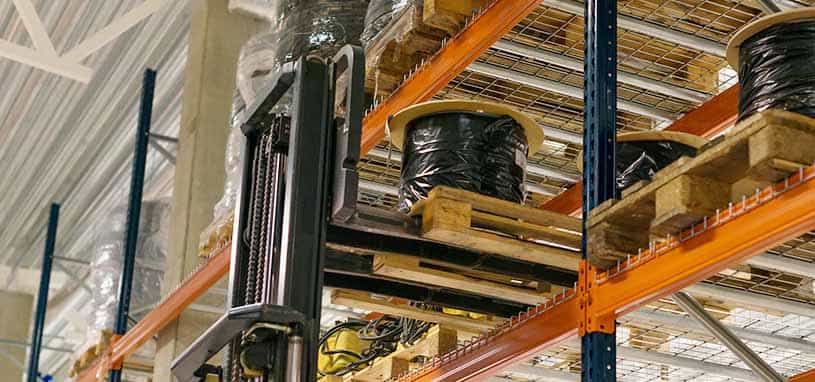How to ensure your pallet racking is not a safety risk
Pallet rackings take a beating from bearing heavy loads, and can suffer damage from warehouse equipment such as forklifts, too.
That’s why Australian Standards say pallet racking should be inspected for damage and overloading frequently – and at minimum, once a year – to ensure its integrity.
Failure of pallet racking can result in life-threatening collapses, followed by days of clean-up and huge damage bills.
It is important to bear in mind that while all pallet racking has a load rating, you can't rely on this alone. If your racking is damaged then that full load capacity originally posted on it may be irrelevant.
Plain Pallets is committed to bringing you information on safe working practices around pallets. For more tips on issues around pallet maintenance, get in touch with our friendly team.
What to look for when inspecting pallet racking

WorkSafe Victoria provides guidance on how pallet racking should be designed, used and maintained. When it comes to inspections, they recommend you ask yourself the following questions.
- Are your beams overloaded? A large amount of deflection indicates overloading of the racking. If racking is or has been overloaded, the beam connectors may be deformed (forming a ‘V’). It will look like this even in unloaded beams.
- Are your beams or welds damaged? Check for obvious signs of beams being hit by a pallet or forklift. Damaged beams should be replaced. If a beam has been hit and is only showing minor damage, ensure welds are checked for cracks by a competent person.
- Are your beam connectors or safety clips missing? Examine beams for damage and replace missing clips. Replacements must be of a design approved by the equipment manufacturer. If clips are regularly being dislodged, contact the manufacturer or installer.
- Has a beam popped out of its upright position? If a beam has popped out this will mean it is only suspended on one end by a connector and could collapse.
- Are rack load signs posted? Ensure bays display the Safe Working Load signs provided by the manufacturer or installer and that the original rack configurations have not been altered.
- Are uprights damaged? If an upright shows significant damage – for example, if it is twisted or contains splits or cracks – replace it or splice it in a new section. Splices should be approved by the equipment manufacturer. If the upright is damaged, replace both it and the footplate.
- Are splices in good condition? Check the condition of all splices. They should be above the first beam level, not below 1.5 metres, and no more than one splice should be between any two adjacent beam levels.
- Is the racking vertical? Out-of-plumb racking is usually caused by incorrect installation but can also be the result of impact, overloading, or settling of the floor slab. Contact the manufacturer or installer.
- Are racking braces damaged? Replace bent, horizontal or diagonal braces. For bracing, the member deviation from a 1-metre-long straight edge in either plane should not exceed 10 mm.
- Are floor fixings installed? Check floor fixings are installed and undamaged. If damaged, replace it and the footplate. At least two anchors are required in each footplate.
Minimising damage to racking

- Installing racking with beams at knee-height in the bottom bay can help to reduce damage caused by pallets hitting the uprights, footplates and bracing while being lifted by forklifts. It can also make manual picking activities easier, as it raises the height of the items to be picked.
- Protective products, such as guard rails and post protectors, are low-cost and highly effective at protecting pallet racking from forklifts.
What to do if you do spot damage
Worksafe Victoria's guidance notes provide a Damage Action flowchart that explains what you should do in the event your inspection reveals either very serious damage, hazardous damage or acceptable damage to your pallet racking.
For more information on OHS around pallets, visit WorkSafe Victoria’s website and see related Australian Standards Compliance Codes:
- AS 4068:1993 – Flat pallets for material handling
- AS 4084: 2012 – Steel Storage Racking
- AS 4762: 2000 – General purpose flat pallets: Principal dimensions and tolerances
Contact Plain Pallets for all your pallet needs. We are Melbourne's pallet experts, and we stock a wide range of wooden, plastic and steel pallets.
We specialise in used pallets, which are more affordable and better for the environment, and we deliver across Victoria.
Get a quote online, or speak to our sales manager Matt Troy on 03 9545 7344.
Must Read
Plain Pallets on 29 April 2014
How to Get Greater Mileage out of Your Pallets
Do your pallets go the distance? If not, you may be losing money through replacement costs and damaged goods. Get the most out of your pallets ...
Read morePlain Pallets on 11 March 2014
Plain Pallets Display the Future of Sustainability
Pallets are always useful. See the many ways old pallets can be reused. Who knows, maybe your next house or business will have some great pallet furniture! ...
Read more